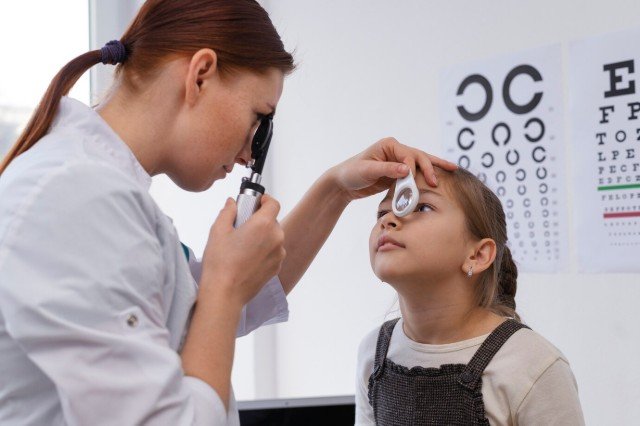Ensuring your child’s vision health is a critical aspect of their overall well-being and development. Regular eye examinations can detect potential issues early, facilitating timely intervention and support. This guide aims to assist parents in understanding the importance of pediatric eye care, recognizing signs of vision problems, and locating a qualified pediatric eye doctor near me.
The Importance of Pediatric Eye Care
Children rely heavily on their vision for learning and development. Undiagnosed vision problems can lead to difficulties in school and social settings. Regular eye exams are essential to identify and address issues such as refractive errors, amblyopia (lazy eye), and strabismus (crossed eyes) early on.
Recommended Schedule for Pediatric Eye Exams
The American Optometric Association recommends the following schedule for children’s eye examinations:
- First Exam: At six months of age to ensure normal visual development.
- Second Exam: At age 3 to detect any emerging vision problems.
- Before Starting School: At around age 5 or 6 to ensure readiness for academic activities.
- Ongoing: Every two years if no vision correction is required; annually if the child wears glasses or contact lenses.
Recognizing Signs of Vision Problems in Children
Parents should be vigilant for signs that may indicate vision issues, including:
- Frequent eye rubbing or blinking.
- Short attention span for age-appropriate tasks.
- Avoiding activities that require near vision, like reading, or distance vision, like playing catch.
- Complaints of headaches or tired eyes.
- Tilting the head or covering one eye to see better.
If any of these behaviors are observed, scheduling an appointment with a pediatric eye doctor near me is advisable.
Finding a Pediatric Eye Doctor Near Me
To locate a qualified pediatric eye doctor in your area:
- Utilize Online Directories: Websites like the American Association for Pediatric Ophthalmology and Strabismus (AAPOS) offer searchable databases of specialists.
- Consult Your Pediatrician: They can provide referrals to trusted pediatric eye care professionals.
- Check with Your Insurance Provider: Ensure the eye doctor is within your network to minimize out-of-pocket expenses.
- Read Reviews and Testimonials: Online reviews can offer insights into the experiences of other parents and the quality of care provided.
What to Expect During a Pediatric Eye Exam
A comprehensive pediatric eye exam typically includes:
- Case History: Discussion of the child’s medical history and any vision concerns.
- Visual Acuity Tests: Assessments to determine how clearly the child sees at various distances.
- Eye Alignment Tests: Evaluations to ensure the eyes are working together properly.
- Refraction Assessment: Determination of any refractive errors like nearsightedness or farsightedness.
- Eye Health Evaluation: Examination of the internal and external structures of the eyes.
These tests help the pediatric eye doctor near me to identify any issues and recommend appropriate treatments or interventions.
The Role of Vision Screenings vs. Comprehensive Eye Exams
While vision screenings, often conducted in schools, can detect obvious vision problems, they are not a substitute for comprehensive eye exams. Screenings may miss subtle issues that a thorough exam by a pediatric eye doctor near me could uncover.
Addressing Common Pediatric Eye Conditions
- Refractive Errors: Conditions like myopia (nearsightedness) and hyperopia (farsightedness) can be corrected with prescription glasses.
- Amblyopia (Lazy Eye): Treatment may involve patching the stronger eye to strengthen the weaker one.
- Strabismus (Crossed Eyes): Options include vision therapy, glasses, or surgery, depending on severity.
Early detection and treatment by a pediatric eye doctor near me are crucial for effective management.
Preventative Measures for Maintaining Children’s Eye Health
- Encourage Outdoor Activities: Spending time outdoors has been linked to a reduced risk of developing myopia.
- Limit Screen Time: Excessive screen time is associated with an increased risk of myopia in children.
- Promote Healthy Diets: Nutrients like omega-3 fatty acids, lutein, and vitamins C and E support eye health.
- Ensure Proper Lighting: Adequate lighting reduces eye strain during reading and other close-up tasks.
The Impact of Digital Devices on Children’s Vision
In today’s digital age, children are exposed to screens more than ever. Prolonged screen time can lead to digital eye strain and may contribute to the development of myopia. Implementing the 20-20-20 rule—taking a 20-second break every 20 minutes to look at something 20 feet away—can help alleviate eye strain.
Conclusion
Prioritizing your child’s eye health is essential for their overall development and academic success. Regular comprehensive eye exams, awareness of vision problem signs, and proactive preventative measures can ensure your child’s vision remains optimal. Utilizing resources to find a qualified pediatric eye doctor near me will provide the professional care necessary to address and manage any vision concerns effectively.




